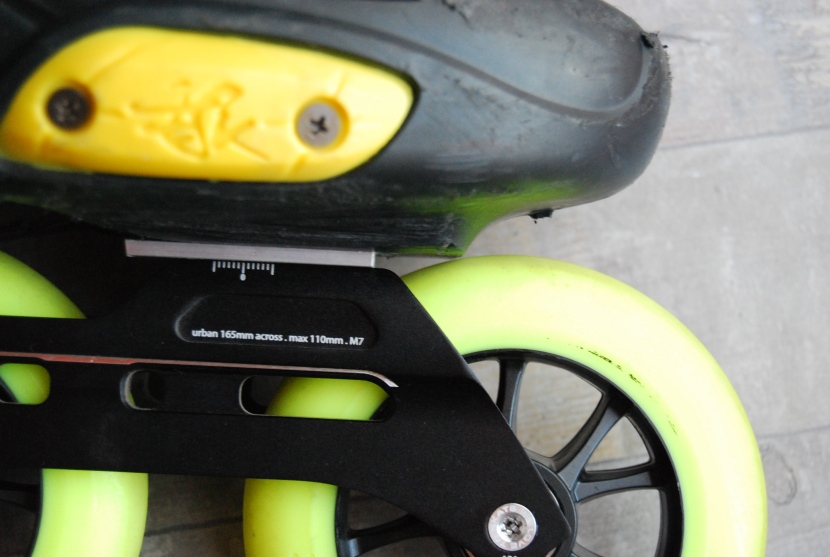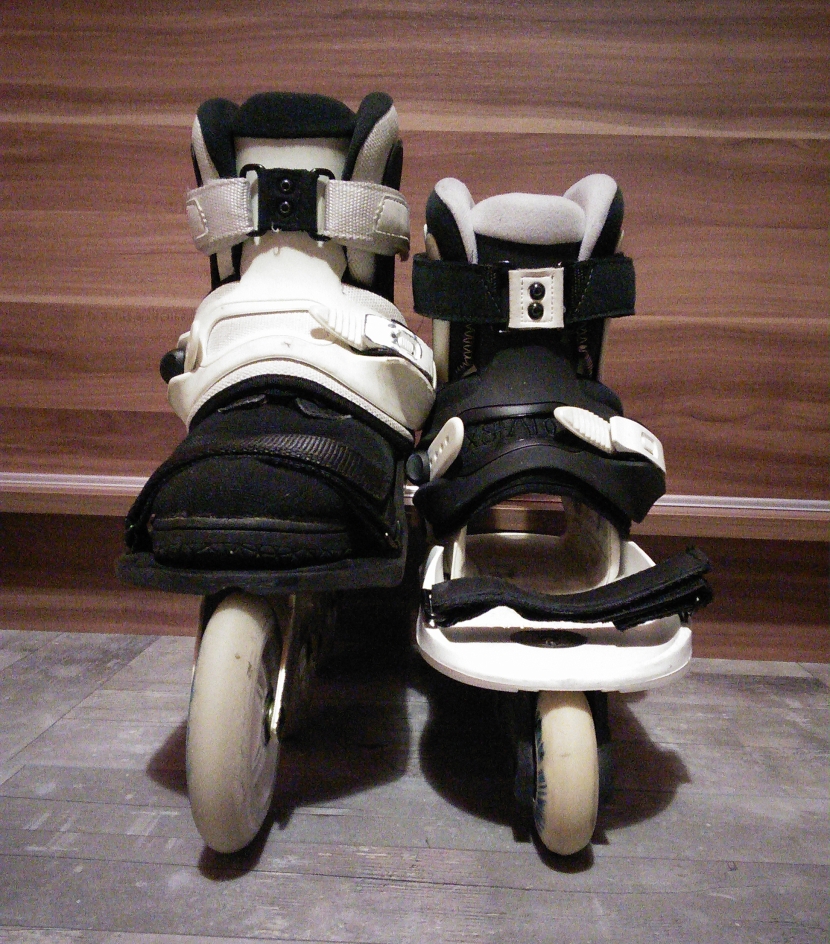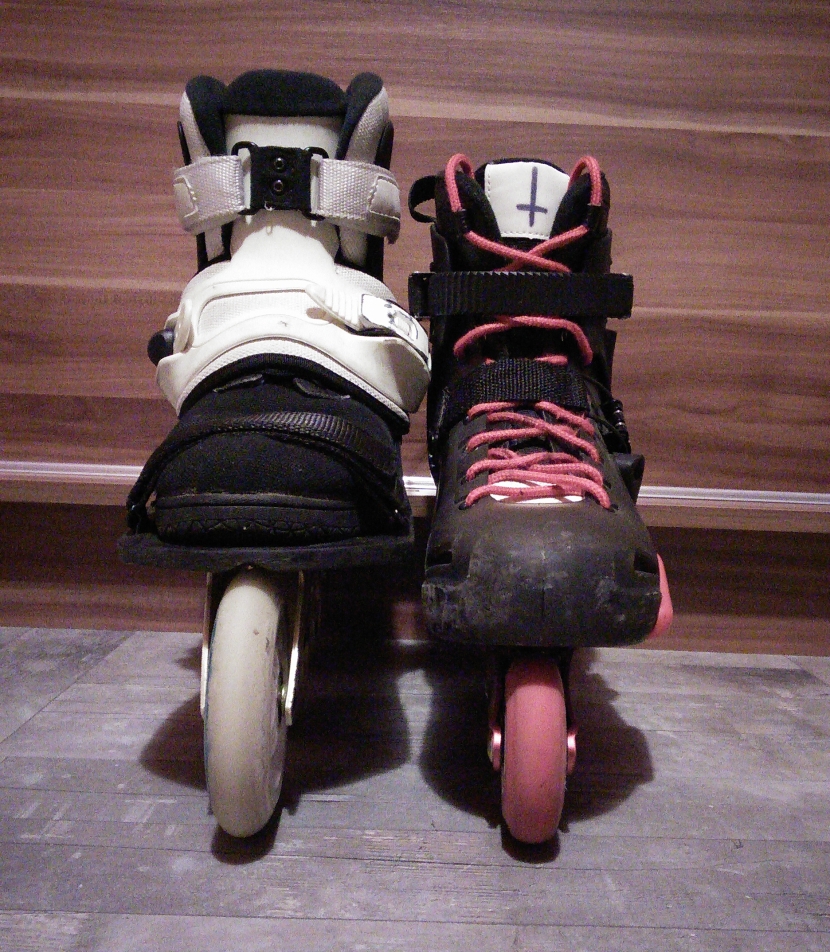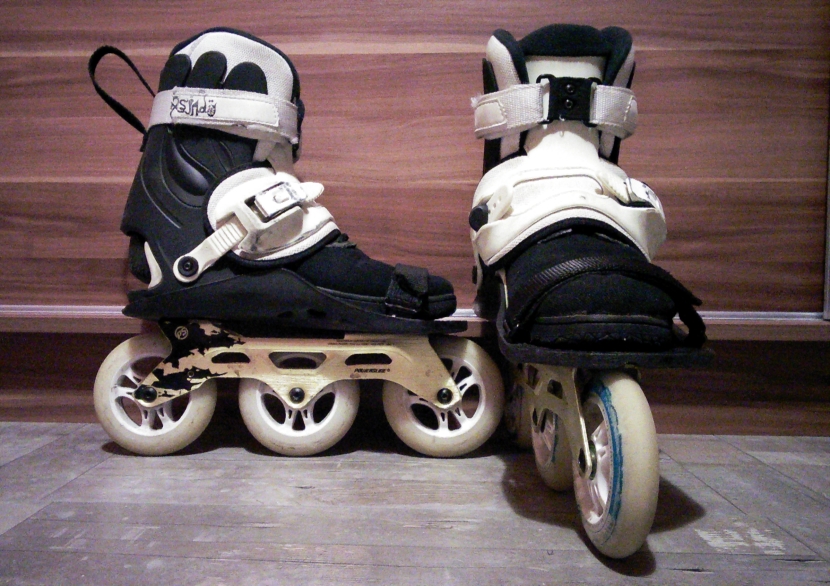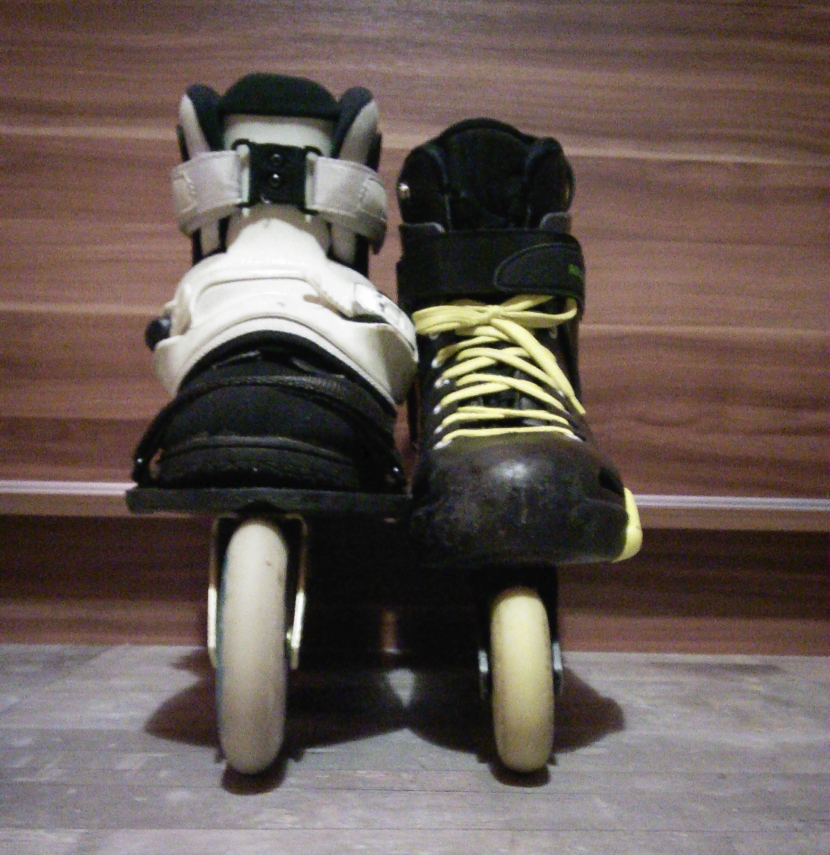Tagged: 3×110

Trinity system – incoming revolution
A few weeks ago I had a chance to participate in two-day meeting with one of Powerslide central representatives. Well, I was present only for one day, because of my job, but what a day it was. Whole thing took place in Warsaw and goal was to test and give feedback about PS products planned for release in season 2016. A lot of people were there, some of them are PS representatives or skaters, others without any brand affiliation, one was supported by Seba. Our group was very diverse – there were aggressive skaters, freeskaters and people who specialize in freestyle slalom and/or slides.
We had two big boxes of stuff to play with, but main dish were prototypes of new Tau skates. We also had a chance to try earlier prototype of a Kaze model, used for a few months by Piotr Combrzyński (one of best aggressive skaters in Poland). Both boots are equipped with new “Trinity” frame mount this text will focus on.
Apart from boots, we had a lot of frames to check. 4x80mm, 4x84mm, 3x90mm, 3x100mm, 3x110mm and 3x125mm options were available to use with new line of Undercover wheels. We had spent almost as much time switching framesets and boots as skating them.
I can say without exaggeration that we all were under huge impression of new Trinity tech from Powerslide. Me and one of colleagues came up with a conclusion that after trying how it works, we don’t really want to be back on skates with SSM and LSM frame mounting systems. Those, literally, don’t have any advantage over Trinity!
So, what actually is Trinity system? As you should guess by now, it is a new frame mounting system – and one designed to make setup height as low as possible. How Powerslide managed to achieve such goal? It is very simple – instead of single front mounting bolt placed directly over wheels, here we have two of them on the sides.
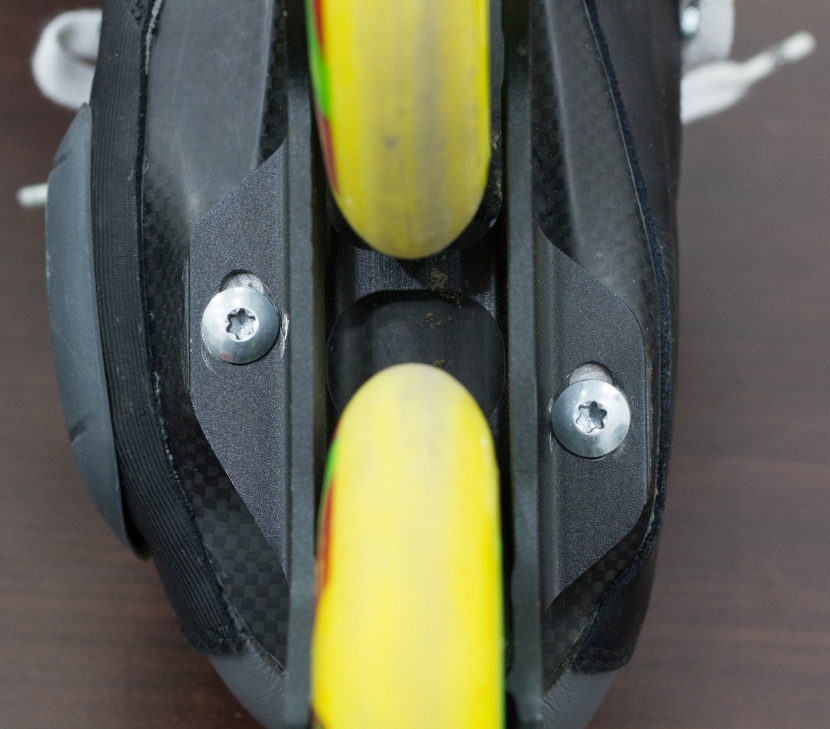
It creates an opportunity to make frames lower, as there is no need for raised mounting block in front of the skates, no problems with bolt placement going in the way of the front/second wheel etc. It also fixes the problem with centering of the frame under the boot in cases of 3×110 and 3x125mm framesets coupled with some boot sizes.

What are other advantages of Trinity over SSM/LSM?
- Lowest setup height possible – while that’s true there are some specific cases where Trinity won’t make any/much of difference, like long speedskating 3x125mm frames for example, there aren’t many of them. It works wonders with roughly 90% of usual setups you’d want to put under your feet. With 4x80mm frame you get a sensation of skating something more akin to aggressive skates (in terms of height, not speed!) than freeskates. When I’ve put on skates equipped with short 3x125mm frames and corresponding wheels, I wasn’t aware I was on something larger than 3×110 until a friend told me (wheels were some generic/prototype ones, with core similar to used in many 110mm wheels so I’ve overlooked their size).

I bet that Trinity mount will make largest impact on speedskating, making 3x125mm setups more accessible for skaters with smaller body frame and feet. It makes such setup much easier to handle, so argument that 125mm wheels benefit only large and strong skaters is gone. In freeskating side of things we are facing a small revolution. Out of sudden 90-100mm setups are more manageable for average skater and even in cases of smaller wheels, lowered centre of gravity is a welcome change. - Improved energy transfer – with three points instead of two, frame-boot connection is more stable and solid. The frame doesn’t flex as much around bolts during strong pushes, making it easier to accelerate and to skate faster. Frame structure itself feels more rigid – it is, after all, held in place with two bolts at the front, with underside of the boot making an arch over it, reinforcing whole setup further.
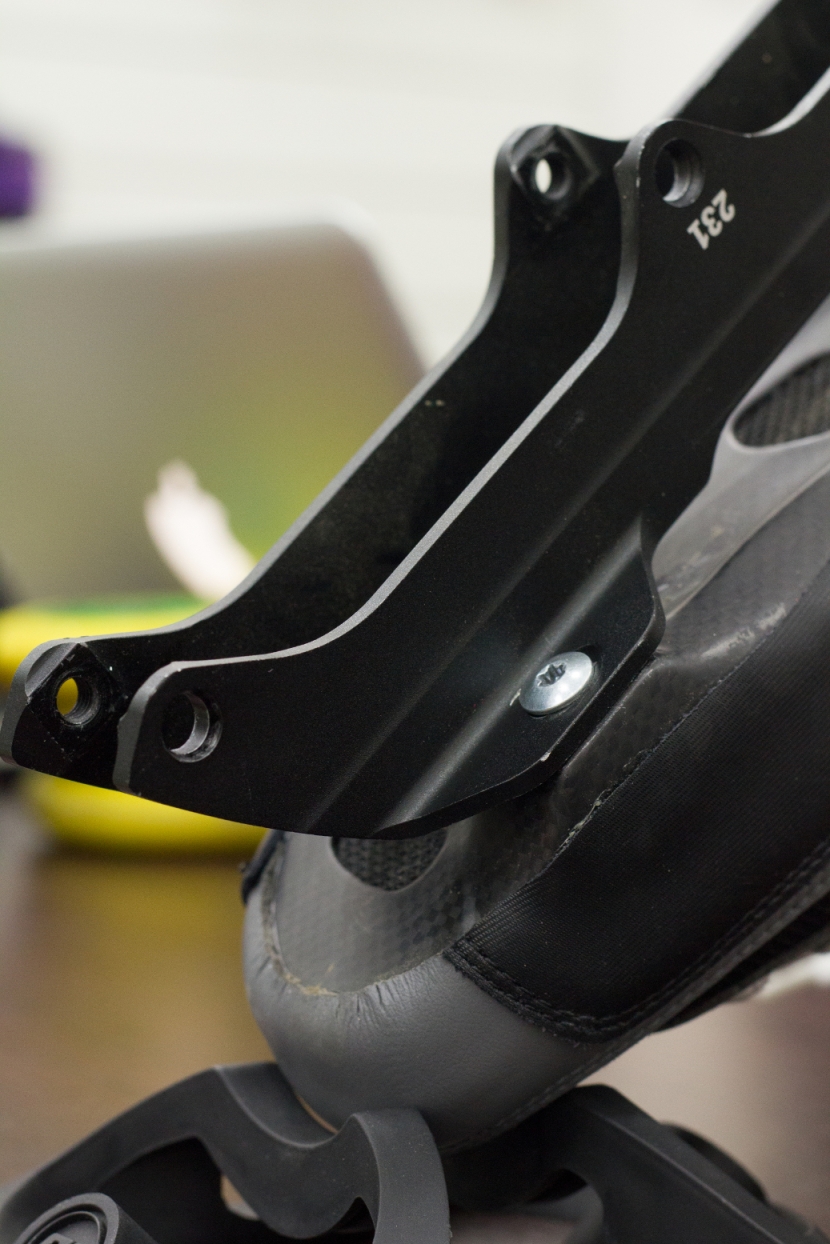
- Versatility – think of UFS for non-aggressive skates, but with much better execution. Every frame using Trinity system will fit every boot! There is no need for two standards like in case of SSM and LSM – because there is no need to design the frames around front bolt placement. It also does mean that it’s always possible to centre the frame under the boot properly, without front or rear wheel sticking out too much from the underside. You can use speedskating frame with a freestyle boot like Kaze without any problems. I’ve even tried prototype of a hockey boot with a 3x125mm frame!!!

- Better vibration dampening – no joke, boots feel much “smoother” when skating, because of forces and shocks being distributed more evenly on surface of boot sole, thanks to three contact points instead of two. It’s only minor bonus, but with new generation of one-piece boots that are designed to be usable without additional insole, it’s a good thing.
If you are worried about frames availability in the future, please don’t. Powerslide is treating this whole thing seriously and will provide numerous options, from 4x76mm wheel frames up to 3x125mm ones. I even had a chance to skate 3x90mm frame of 220mm length – afaik nobody has released something similar before.

Skates we’ve got a chance to try are not final versions and a lot can change until their release, but I’ll give you some insight – about Kaze and Tau at least, hockey boot is still at early stage of development and to be honest I’m not very qualified to judge how hockey boot performs.
Kaze seems like a worthy successor of current Ultron design – universal skate based on one-piece boot with composite shell, suitable for freeskating and freestyle slalom. Lining, foams and upper skin are pretty stiff and hold foot in place well. The skate worked for me perfectly in size EU42 after removing insole (I normally skate EU43), was comfortable and efficient – fast and responsive, as you want freeskating boot to be. As it will be based on composite shell (with addition of glass fiber to reinforce it) its price should be lower than of Tau. Only thing I’ve disliked was a bit too soft tongue and too much forward flex caused by this – I like tongues like in Phoenix liners, which are more supportive and do a very good job in locking heel down. But, on the other hand, a better forward flex allows you to go lower on skates, making possible to squeeze more speed out of big wheeled setups. Boot is reasonably light, not the lightest skate you can find, but remember it is based on composite shell, not a carbon one!
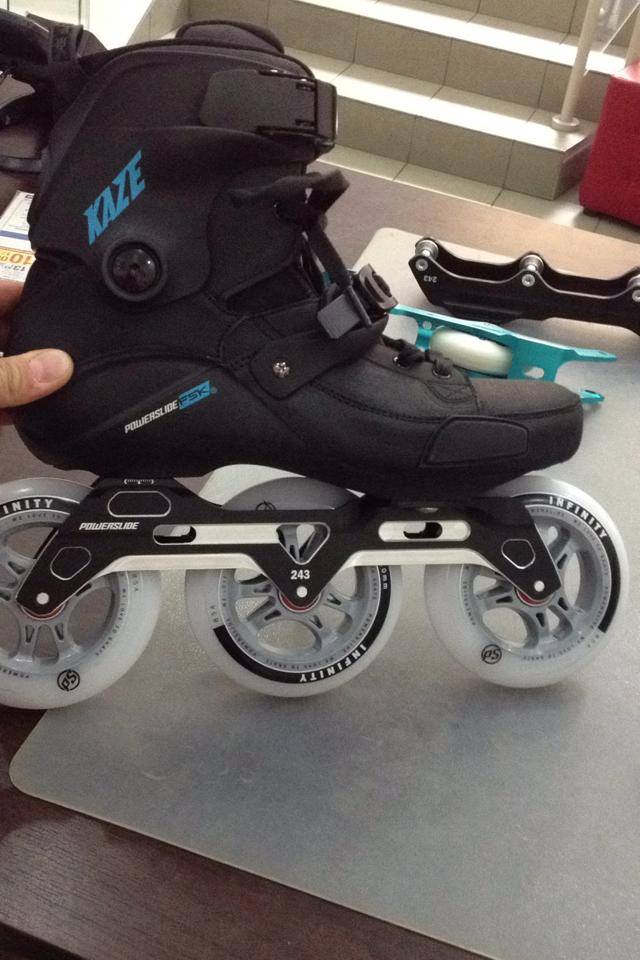
I think Kaze have a potential to become a very popular choice if Powerslide will back it up with good promotional campaign, read: don’t just release it on the market and expect people to buy it without explaining advantages and idea behind it, like in case of horribly under-promoted and underrated Ultrons many people believe to be not-that-cheaper alternative to freestyle Hardcore Evo (while they are more of a Carbon Free remade to be urban/freeskate).
Main dish prepared for 2016 (hopefully!) is named Tau, though. This boot uses latest and best technologies available to Powerslide and it shows. Apart from Trinity frame mounting system, it does have new pain-free shell (read: shell is cut out in places when pressure points issues surface often) made out of compressed carbon (not “simple” laminate). It makes skate base lighter than one made of traditional carbon freestyle boot, like Hardcore Evo for example, without losing rigidity. Skate itself is very light and fits like a glove – responsiveness and energy transfer are excellent and it’s almost impossible to skate slow in these. You can really feel you have sophisticated sports equipment under your feet, not some toys.

Tau prototypes were not perfect, though and require some tinkering in ankle area to provide better comfort. Still, Tau are already bursting with potential – it was the skate I’ve liked the most out of all new boots I got a chance to skate that day, even though it was two sizes too small (EU41) and even without insole it was making my toes a bit numb. Wider style toe-box is more similar to ones in skates like PS Ultron, USD Carbon or Seba SX than to the one in Hardcore Evo and it for sure helped a lot – with narrow one I probably wouldn’t be able to skate EU41 Tau at all.
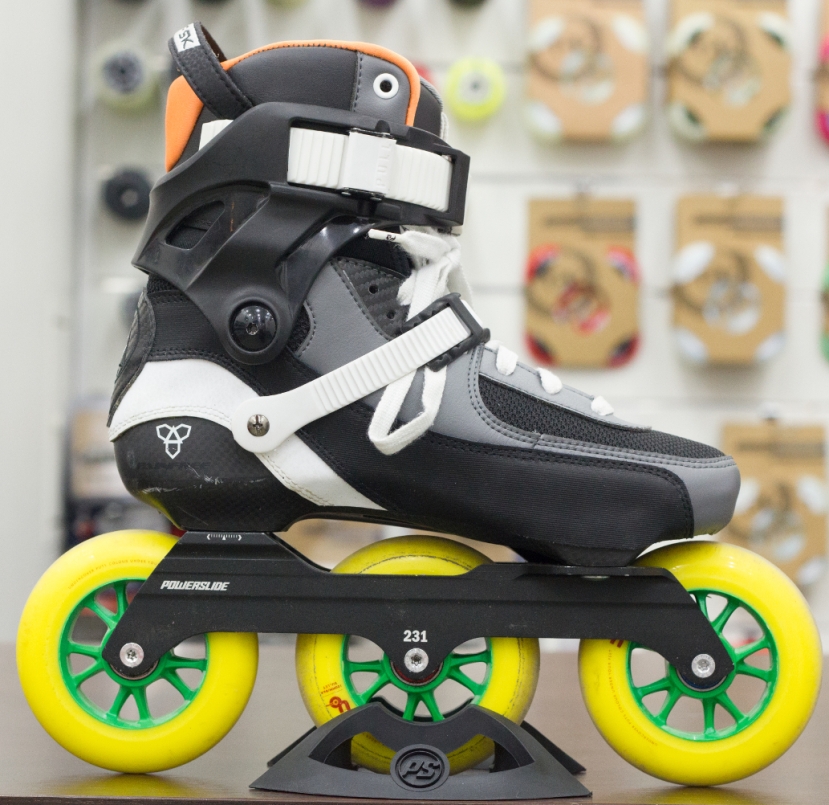
Apart from three new boots based on new Trinity standard, Powerslide is planning to release fourth, designed to be semi-race/marathon skate. I’m sure they will eventually release a proper speedskating boot too, as it would be foolish to not to. To be honest, if I would be in charge, I would try to introduce Trinity anywhere it’s possible, as older SSM/LSM standards do not have any advantage over it. It is a “gamechanger” or you might say a “killer feature” that competition won’t be able to match anytime soon. Coming up with another solution to lower setup height without copying PS invention will be a very difficult task.
There aren’t any major disadvantages, but if you are picky, you can see two (very) minor ones. The boots do have something similar to X-Slot (it is reversed here, though – frames have holes for longitudinal position adjustment and small movable plates in boots are used for lateral fine-tuning) but you don’t have as much freedom in adjusting frame to the sides. Still, it is much better than in case of UFS standard, with fixed frame position, which I grew used to over the years.
Second „problem” is a fact you will be limited to Powerslide frames only. But, to be honest – how often were you replacing frames on boots with SSM mounting with ones made by different manufacturer? Consider that SSM is a very loose standard anyway and not always everything works properly. It’s hard to find an after-market frame that would be centred correctly under Rollerblade Tiwster of Seba WFSC boots, for example, and even when using the same manufacturers boots and frames (not designed for the boots specifically) you don’t have 100% guarantee that everything will go smoothly, just as my test of PS Pleasure Tools and FE Supersonic proved… Every Trinity system frame I got a chance to try was made of high-grade aluminium and had great finish and there will be plenty of options to choose from, so I’m not really worried. And every single one of them fits correctly on boots.


I know this text reads like and advertisement, because I’m praising the whole thing so much. It couldn’t be any different, though, because Trinity is probably the freshest and most exciting invention introduced in inline skating for years – it redefines how many setups skate (for example it makes 3x125mm option truly viable for urban skating, when I’ve felt previous solutions were way too sketchy) and fixes long known problems of frame height and placement that were present in SSM/LSM mounting standards.
It’s hard not to be excited! I knew about whole thing since start of 2015 when first leaks from ISPO were to be found on Instagram and had lukewarm feelings towards it at best, but trying is believing.
I literally can’t wait to get my own pair of skates with Trinity system and will try to snatch one ASAP, and if you are planning to buy high-end freeskates in 2016 I’d say wait for the release of Kaze or Tau – it’s worth to do so.
You shouldn’t jump on Supercruiser/Megacruiser frames

So, here’s the story. I gave Supercruiser frameset to my skating pal. He managed to bend them. I was cautious and haven’t jumped on those while using them, he wasn’t. And he is not a large guy, shorter than me (but more muscular), so he weights 80kg max, certainly no more. It seems 8 stair set is too much for these frames to handle.
Well – not surprising. Fitness frames have durability of …fitness frames, lol. I kind of expected that to happen, sooner or later.
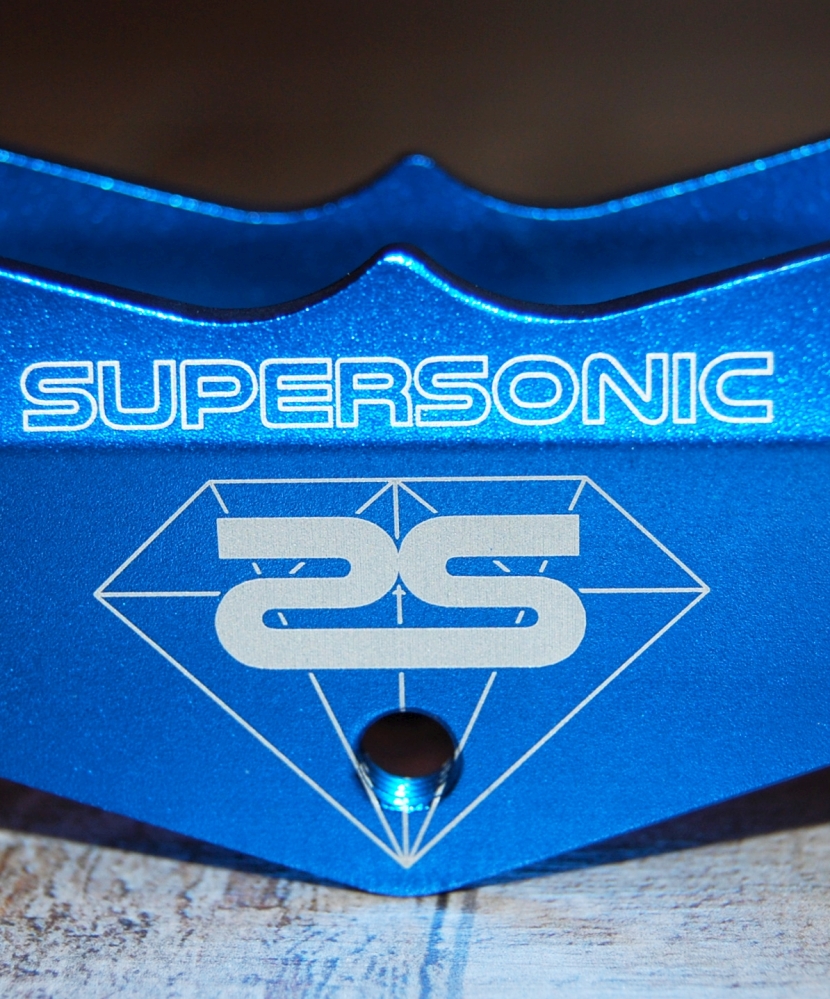
Look at: Flying Eagle Supersonic
If you would tell me three years ago that I’ll be excited for Flying Eagle product in 2015, I would call you crazy. I knew the brand to be some Asian business specialized in making skates that looked strangely similar to Powerslide, Rollerblade and Seba offerings. I thought they were only a cheap knock-offs, that Flying Eagle won’t ever release something that would be worthy of attention. In the longer run, this proved to be untrue and I find Flying Eagle more and more surprising – in a good way. Stereotype that says skates made in China are cheap and low quality is very strong among experienced skaters and I admit I was “infected” with it, too.
My point of view started to change when Oli Benet bet his money and reputation on them, starting his own business, Roex skateshop. I have huge respect for the dude, he does have years of experience working in rollerblading industry and even more years of experience on skates. When someone like him does something so crazy as trusting relatively unknown China brand, you should at least have a spark of interest in his reasons. Especially when a growing number of skaters in Barcelona and whole Spain claim Flying Eagle brand products are good.
Earlier this month I’ve received a package sent by Oli from Roex. It included custom Flying Eagle Falcon setup, with still fresh Supersonic frames and 110mm 85A FE wheels. As far as I know, wheels are still not up for sale – I’ll write more about them in another article. Boot has been on the market for some time and it deserves another piece, too, especially as I want to give it a proper, honest review.
 This article will focus only on the frames and how they compare to Powerslide Pleasure Tool, their main competition – leaving absurdly priced Seba 310 aside – in 3×110 freeskating frames market. Supersonic are a “special case” for me, because I had an eye on this project since the very beginning and saw early designs, had my expectations – and was actually waiting for their release.
This article will focus only on the frames and how they compare to Powerslide Pleasure Tool, their main competition – leaving absurdly priced Seba 310 aside – in 3×110 freeskating frames market. Supersonic are a “special case” for me, because I had an eye on this project since the very beginning and saw early designs, had my expectations – and was actually waiting for their release.
Supersonic frames come in four colour variants: black, blue, red and purple. That’s a nice touch as you can choose a colour that will match your skate. Personally, I would also add yellow/gold and green to the rooster, but most frames come in only one colour, so FE is already generous with four. I got blue one, as that’s my favourite colour.
Frames are of 251mm length, so 8mm longer than Pleasure Tool frame. That’s nothing to worry in case of urban skating. Of course, there’s a difference, but it is so slight that frame length should be least important factor when choosing between the two – at least in urban skating case.
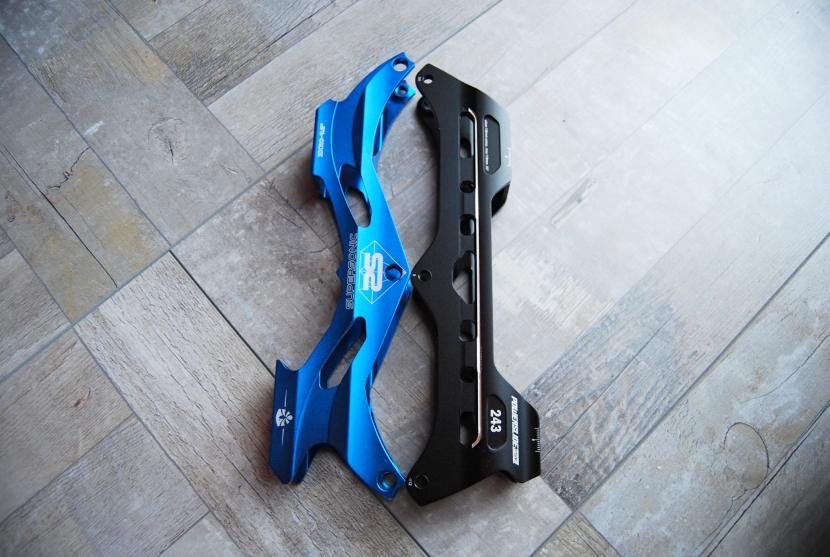 I haven’t experienced any problems with sharp turns, stopping, transitions from front to back etc. It’s all very similar to skating on Pleasure Tool frame and there’s no time required to adjust after switching between the two – both frames use the same wheel placement, two rear wheels close together, first wheel a bit further apart. Shifting your weight to the heel a bit makes turning almost independent from first wheel, so additional 8mm don’t play much role here. Supersonic works perfectly as 3x110mm frame.
I haven’t experienced any problems with sharp turns, stopping, transitions from front to back etc. It’s all very similar to skating on Pleasure Tool frame and there’s no time required to adjust after switching between the two – both frames use the same wheel placement, two rear wheels close together, first wheel a bit further apart. Shifting your weight to the heel a bit makes turning almost independent from first wheel, so additional 8mm don’t play much role here. Supersonic works perfectly as 3x110mm frame.
I can’t give a fair opinion on how these are suitable for speed slalom, though. I don’t skate freestyle slalom and probably wouldn’t be able to speedslalom my way out of a paper bag, but I know freestyle girls and dudes are obsessed over length of their frames, and they have good reasons – so I think it’s safe to say PT have advantage here due to being shorter.
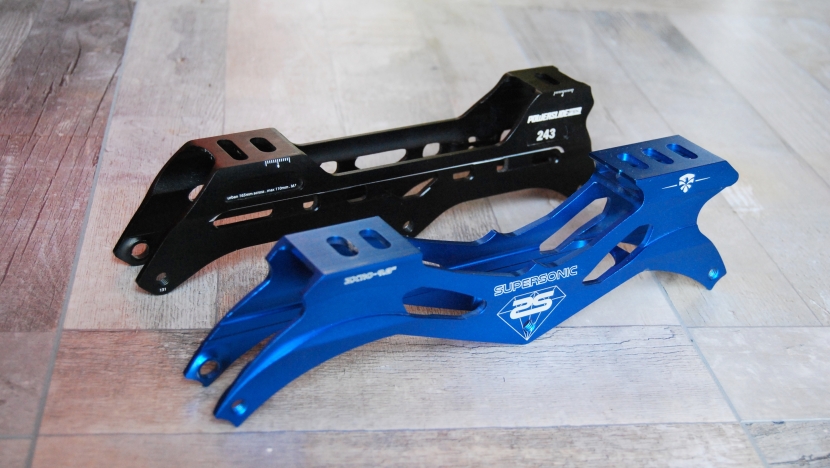 To be honest, I think it’s wrong to compare these two frames in single category, it being either “urban skating frame” or “speedslalom frame”. Obviously, Pleasure Tool were built with speedslalom in mind, while Flying Eagle opted to make Supersonic an urban skating frame first and foremost. Priorities were different and both ways bring different consequences: Pleasure Tools is less compatible with harboots but shorter and lower, Supersonic is more universal but a bit longer and higher, to fit most skates better – especially hardboots.
To be honest, I think it’s wrong to compare these two frames in single category, it being either “urban skating frame” or “speedslalom frame”. Obviously, Pleasure Tool were built with speedslalom in mind, while Flying Eagle opted to make Supersonic an urban skating frame first and foremost. Priorities were different and both ways bring different consequences: Pleasure Tools is less compatible with harboots but shorter and lower, Supersonic is more universal but a bit longer and higher, to fit most skates better – especially hardboots.
If you were wondering, you have an answer – yes, these frames fit on my skates without mods and are centred properly. On both Powerslide Imperial and Flying Eagle Falcon. There are no balance problems, no need for additional spacers. That’s always a huge plus.
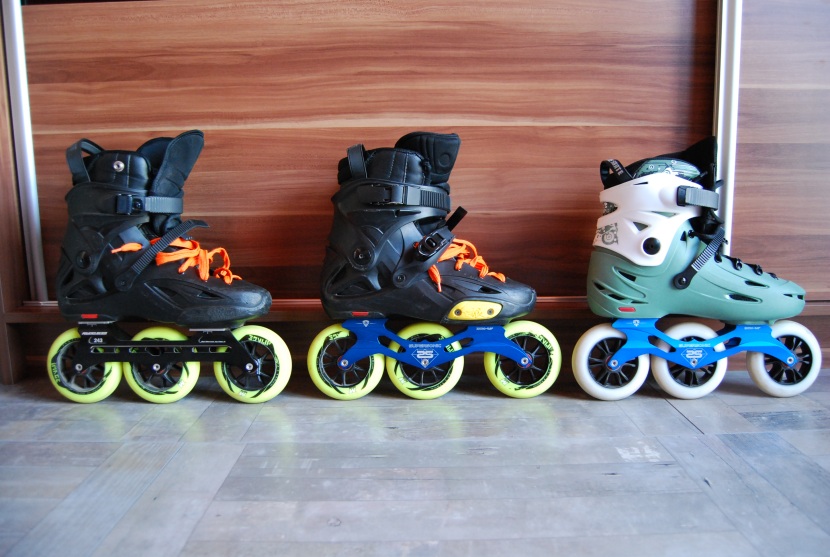 Flying Eagle equipped these frames with two mounting slots at the front and three at the back, giving people with boots that lack any option to change a frame position a choice – limited – but still, better than nothing. It also means Supersonic are a safer bet than Pleasure Tool in such cases, if you can’t really try how frame will fit on your boots before the purchase. That’s something I felt was missing in Powerslide product.
Flying Eagle equipped these frames with two mounting slots at the front and three at the back, giving people with boots that lack any option to change a frame position a choice – limited – but still, better than nothing. It also means Supersonic are a safer bet than Pleasure Tool in such cases, if you can’t really try how frame will fit on your boots before the purchase. That’s something I felt was missing in Powerslide product.
As for the frame structure – it is a bit less complex than Pleasure Tools. They are also extruded and CNC machined, of course. As in the case of Powerslide frame, there is no distinction between left and right one – they are symmetrical, with allen key slots in axles placed on your right side.
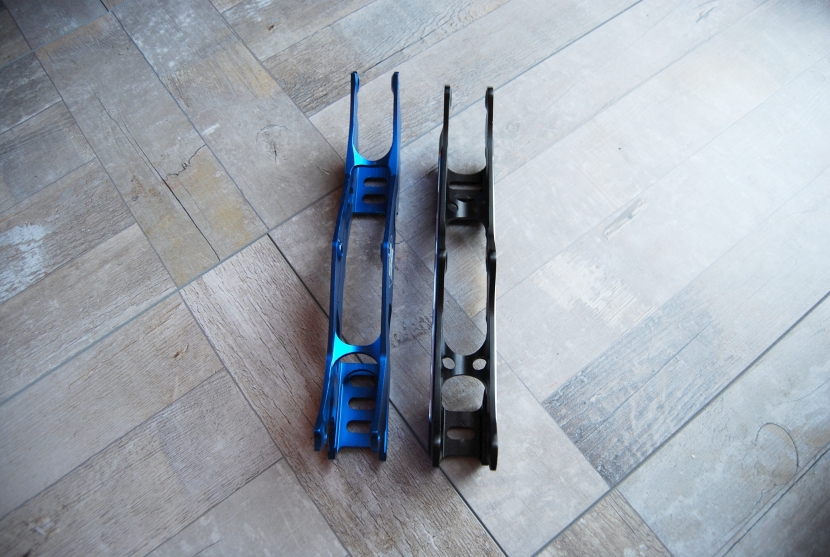 Differences, apart from shape, are subtle – Supersonic frames aren’t curved near the top, internal bridges are also a bit simpler. But truth is, you’ll most likely won’t notice any of it in urban skating – frames are rigid enough for it and there’s plenty of “headroom” left. Not once I’ve had impression they are soft or too flexible at the ends.
Differences, apart from shape, are subtle – Supersonic frames aren’t curved near the top, internal bridges are also a bit simpler. But truth is, you’ll most likely won’t notice any of it in urban skating – frames are rigid enough for it and there’s plenty of “headroom” left. Not once I’ve had impression they are soft or too flexible at the ends.

More complex design and usage of certain tricks to increase rigidity in Powerslide competitor might play a role in speedslalom, giving it an upper hand, but if you are looking for a freeskating/urban skating frame, they do not make real difference in how whole setup handles while cruising.


Finish quality is good and frames are very pleasant to the eye. Their surface is slightly less smooth than of PT, giving them a bit of glossy look. Aluminium compound used here is a 6065 series one, like in many other freeskating frames. Metal is of similar feel and quality as in my old, trusted Rollerblade Fusion 84 frames that are also made with 6000 series. These are nearly indestructible, still, after all those years, so I’m not worried about Supersonic, too. Powerslide frames are made of harder 7005 alloy, which further increases their rigidity – again, it should give them advantage in speed slalom.
Frames come with regular aluminium “racing” axles, the ones that have deep slot for allen key. Over the years of experience with various axles I can say, you’ll most likely won’t be able to round the slot, because of that depth. It’s the most trustworthy axle type in my opinion and I use it in other skates as well – never had any problems. It’s also pretty much standard axle type for many manufacturers, so in the need for the replacement you shouldn’t have problem finding replacements.
I’ve removed the frames off the skates few times to change boots, switched wheels between both my 3x110mm setups and Supersonic threads don’t seem prone to damage. To give you a perspective on how quickly such problems can surface – two threads in my Powerslide Gamma 4x80mm frames broke during second wheel rotation. Axles don’t seize and don’t unscrew during ride. Everything works as it should be.
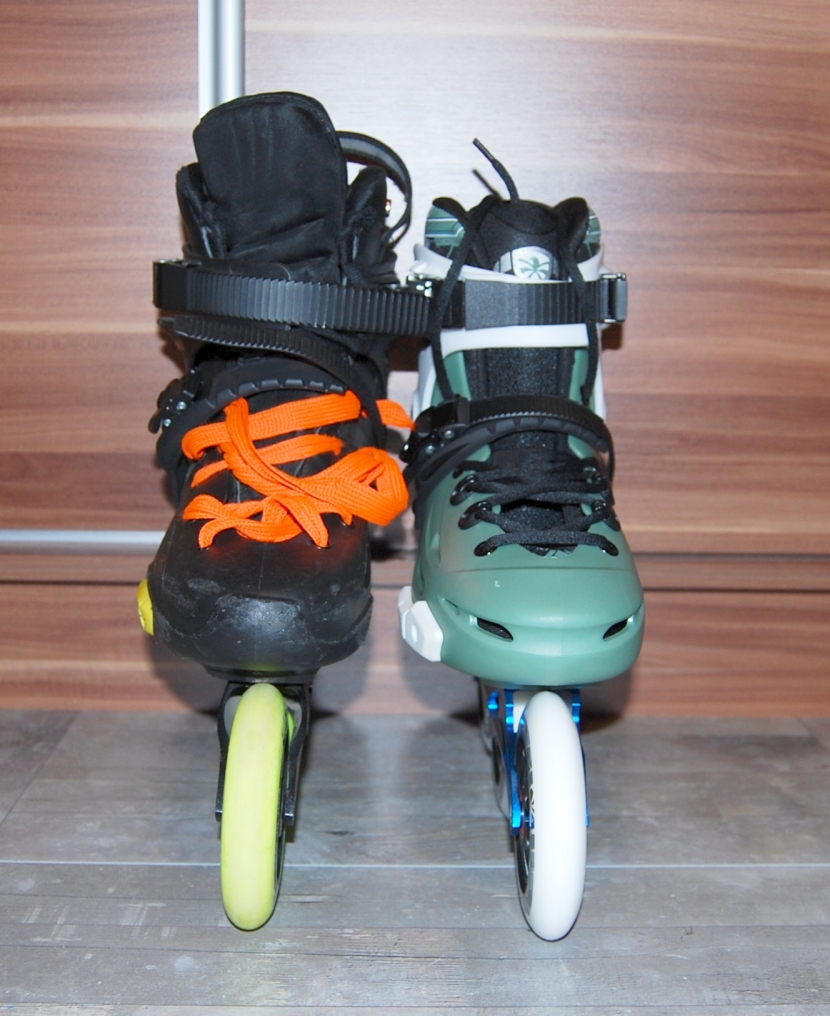
There is only one, and rather surprising, issue with these frames. Because Flying Eagle – in case of Falcon at least – uses thicker bolts to attach the frame to the boot than most other brands (with exception of Seba – they use similar ones), Supersonic could use a millimetre or two of additional clearance in mounting slots. I would move them slightly or make them a bit larger, because right now, when mounting the frame on Falcon boot, bolt thread rubs against metal of the frame, damaging it a bit. While this doesn’t affect the frames in any significant way, I’m worried that bolt thread can get damaged too.
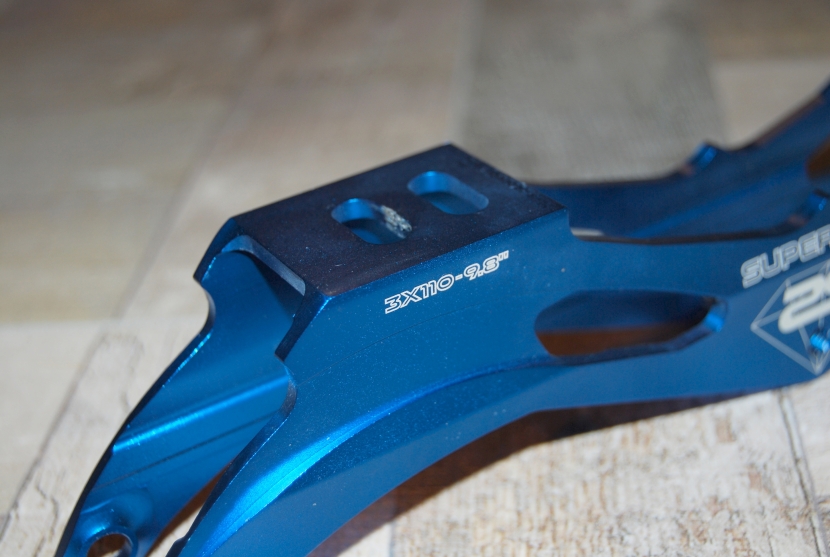 I’m actually amazed that Flying Eagle haven’t made these frames to work with Falcon, their poster-child, without such issues. Of course, if you will use another boot, most likely you won’t notice it – especially if you have skate equipped with X-Slot. I don’t know if the same issue surfaces on Seba FR1 boots, but as they are way more popular than Falcons and use similar bolt size, I felt I need to warn you.
I’m actually amazed that Flying Eagle haven’t made these frames to work with Falcon, their poster-child, without such issues. Of course, if you will use another boot, most likely you won’t notice it – especially if you have skate equipped with X-Slot. I don’t know if the same issue surfaces on Seba FR1 boots, but as they are way more popular than Falcons and use similar bolt size, I felt I need to warn you.
How do they skate? Fast, agile, fun – just like in Pleasure Tool case. Not much else to say, really, no revelation. 3x110mm setup became my “go for” choice for urban skating, taking the mantle from 4x84mm. To be honest, after switching back and forth between between two 3x110mm setups, I still don’t have a favourite – they both skate almost the same to me. In my opinion both Flying Eagle and Powerslide made great 3x110mm frames, even though their products were developed with different principles in mind.
Powerslide product does have advantage in speed slalom application, and if you want a frame to put on your carbon fibre slalom boots, it’s a frame to go for – shorter, lower, with more reinforcements and made of harder material. If you want to shave down precious milliseconds from your personal record, that’s fair to say it’s your first choice.
But if you want 3x110mm setup for general freeskating, and have zero interest in speed slalom, Flying Eagle Supersonic emerges as a winner – because of better compatibility with wider range of skates. Especially if you have feet that are far from tiny and use hardboots – Supersonic just works with these out of the box, without any additional mods. Last, but not least – the cost. For 99 Euros Supersonic is a good deal considering how well this frame is made. I think it is, at the moment, best and most universal choice for urban “triblading” on 110mm wheels, taking all factors in to equation.
Creators of Supersonic should be proud of themselves – they delivered a product that is up to the task. Powerslide raised the bar high with Pleasure Tools, and while Supersonic design is a bit simpler, it’s still a great product I wouldn’t regret spending my money on. Definitely a strong competitor on three-wheeled market and a product worthy of recommendation.
Not much else to say – go, grab a pair of 3x110mm frames of your choice and enjoy, they are truly a game-changer in urban skating.
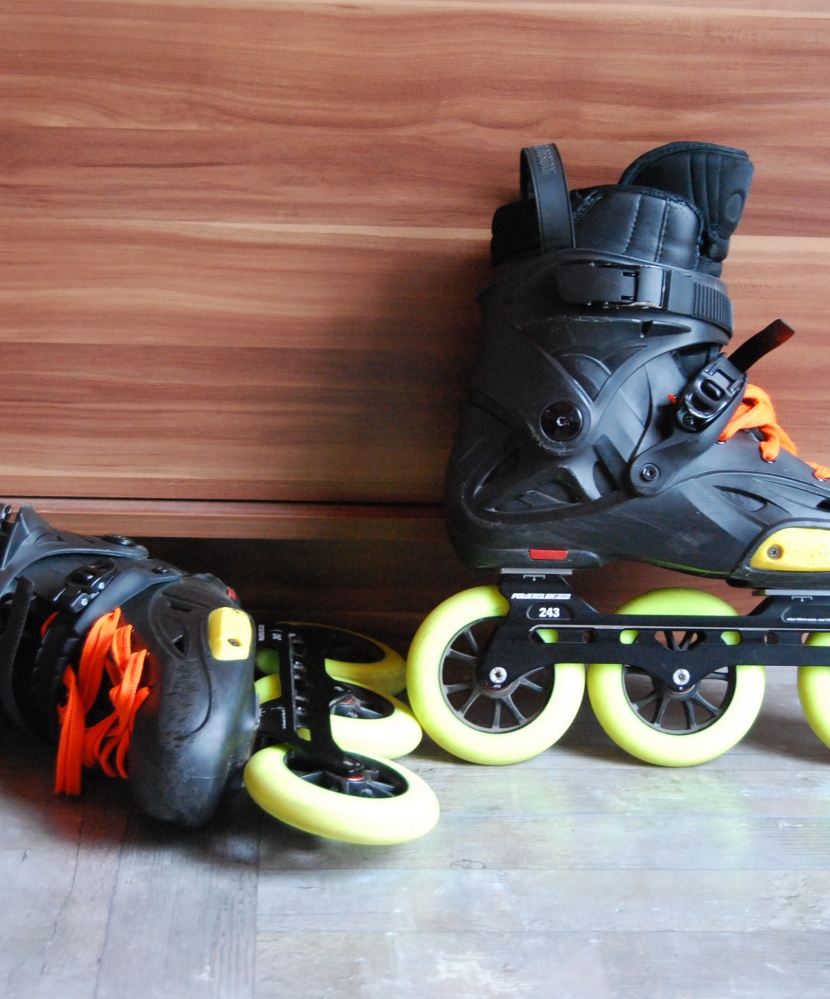
Look at: Pleasure Tool frames
About a week ago I’ve received a package from Polish Powerslide distributor. It contained: Wicked Abec 7 bearings, 110mm Matter Image F1 wheels and pair of Pleasure Tool frames. This article is about frames, as you should deduce from the headline.
Frames are package in a nylon web bag, and come with a set of mounting screws, axles, spacers and a Torx key, which is standard in PS skates. Key isn’t particularly well made – it is a bit too fat at the head to fit in to axles properly, so I’ve got to use my trusted tool. No big deal though, nobody buys frames for a key anyway.
Frames are making great first impression – they are made of strong and lightweight 7005 series aluminium. In terms of build quality they are at the top class of fsk frames and one can compare attention to detail to that known from superb PS Alpha frames. There’s a huge difference compared to pressed (and much, much cheaper – do not forget) Supercruiser/Megacruiser frames. Frames are solid and you don’t have any doubts about their durability. You know it’s a piece of metal you can trust.
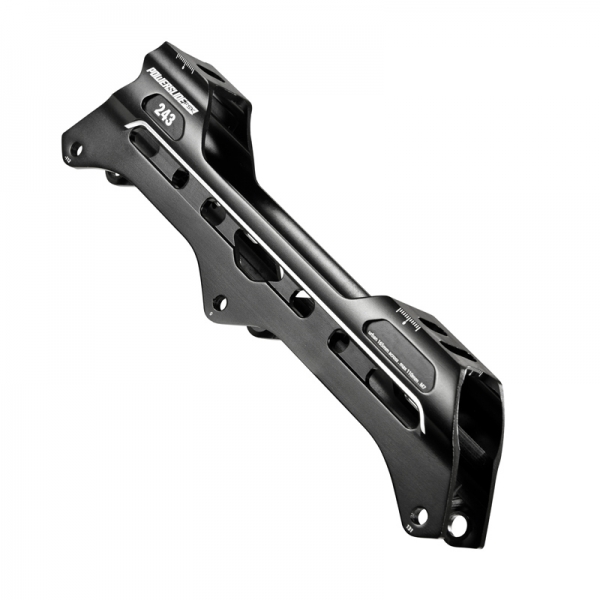
Frame structure does have two internal bridges, and walls are curved below mounting ones. That makes them very rigid. Axles that are included are also of great quality – and I had rather bad experiences with Powerslide axles in the past, so that’s saying something. Design is symmetrical – both frames are the same, there is no distinction between left and right one, and even prints on the frame are placed on both sides. Sharp, firm lines of the frame and good finish make them a good looking pieces of aluminium. Industrial style comes to mind when looking at them.
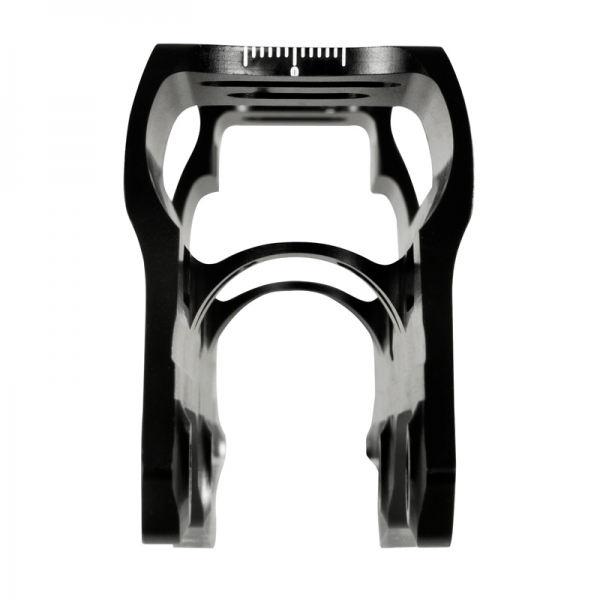
Frame is 243mm long – much shorter than Supercruiser one. Like their competition, Powerslide decided to place two rear wheels closer together. There’s even a print on the frame that informs you that rear axle is placed 112mm from the middle one, and front axle is 131mm respectively. That wheel placement is used to make frame more agile, especially in speed slalom and works well. Indeed, frames turn very easily.
So far so good, but there’s a little problem with these frames. Mounted on a plastic boot they are too far to the front – even on Imperial boot that does have X-Slot system. I wear EU43 size boot and last axle weren’t even directly under my heel when I put them on my skates for the first time. It seems this problem isn’t as bad in smaller shell sizes, as I’ve seen some photos in social media and 3x3wheelers tumblr so if you have small feet you are lucky. In my case, thought, setup was barely usable when I first put skates together.

I know it’s much better in the case of Hardcore Evo, where front mounting block is taller and shorter, leaving more room for the first wheel. Thanks to it, you can position this frame under the boot properly. I guess Pleasure Tool frame was actually designed around Hardcore Evo as a point of reference – it is a speed slalom frame, after all.
You can read a very good article about these frames here:
Author used HC Evo boot, and probably haven’t tried the frames with hardshell skate, so he didn’t bumped on to the same issue I did.
I think Powerslide simply hit the limit of what is possible with standard 165mm v-type frame mounting, again – it happened before when Fila introduced 195mm standard along with 4x100mm fames. There are limitations of two-point frame attachment so if you are aiming to make frame shortest and lowest, natural consequence is that it won’t fit on all boots properly.
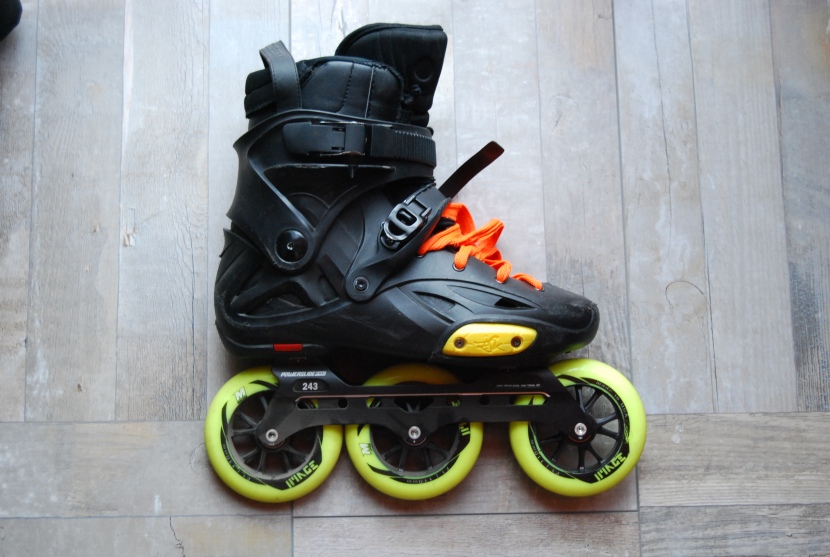
If they would make this frame higher or longer, it could be more suitable for hardboots, but I understand the decision to not go this way, as this is obviously a speed slalom piece of equipment first and that’s where priorities are. What we get is what is best given 243mm length, 110mm wheels, 165mm mounting and height as low as possible. I think a good remedy for such problem could be the new tri-point mounting system that will come next year in skates such as Kaze or Tau – that way front mounting screw won’t come in the way of first wheel, and whole setup would be lower.
But there is one thing I would still change in the design of Pleasure Tool – number of mounting slots. There is only one at the back and one on the front – there is also another, larger hole on the front but I think it’ here to make frame lighter and more rigid, because 180mm would be one weird frame mount spacing.
By making mounting bridges a bit longer and adding another set of slots Powerslide could make frame more universal. In their skates that have X-Slot, frame placement is not an issue, but in boots that do not have such system, or even mounting blocks with multiple holes (for example RB Twister, Adapt Hyperskate Zero, Seba WFSC/KSJ/Trix) there could be problems. With only one pair of slots you are either lucky and frame sits centred under the boot, or it will be pushed too far to the front, or the back – which would make it unusable in some cases.
It is actually strange oversight considering the speedslalom market, where many people would buy these frames because they are a lot cheaper than Seba 310, and more available than cheaper and longer Flying Eagle Supersonic.
How setup with such sub-optimal frame placement skates? Rather badly. When I put my skates on for the first time, they felt like somebody hacked last wheel of a 4x110mm speedskating frame with a saw. Sensation of “falling back” was very strong. After a while I’ve got used to it a little, but it was still uncomfortable and skate was very unstable – I was, to put it simply, afraid to skate like that.
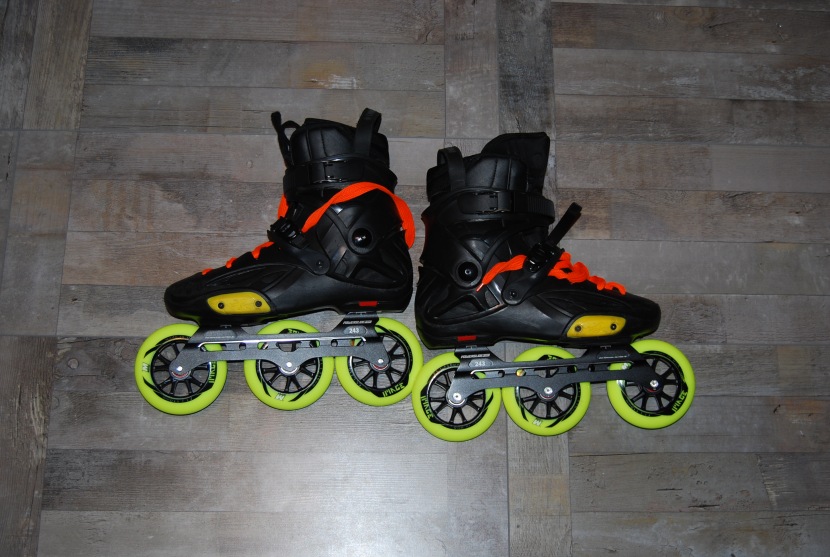
But still, I did about 50km of urban skating with such setup. Because frames were placed so far to the front, turning was very easy. Body weight is placed mostly on two rear wheels and sometimes front one felt unnecessary! Sometimes I forgot it sticks out at the front so much, especially during crossovers – I was lucky to not fall because of this. When I wanted to skate faster, to take advantage of this setup I was forced to shift balance more on to my toes – only that way I was able to get even push with all three wheels.
It all felt very wrong and I couldn’t really skate it, or give these frames justice that way.
I had three options:
–trying another boot, preferably Hardcore Evo – but I’m not crazy to drop that amount of money just to test frames properly…
–skating it that way with hope I’ll get used to it – but a vision of my head hitting concrete after a fall to the back was so suggestive I wouldn’t risk it…
–do something to place the frame in more suitable position – it turned out to be easy enough with some tools
I bought a 3mm thick aluminium bar and made spacers that go between frame and the boot from it. It works very well – I could place the frame more than 2cm to the rear compared to setup without the spacers. Front wheel isn’t sticking out so much anymore, balance is good and whole setup is much more stable. Sensation of falling back is gone.
Additional height is not an issue, I do not feel it at all – maybe because I’ve skated higher Supercruiser frames for a few months. I think Powerslide should actually consider adding such aluminium plates to these frames as a standard – it would make life of owners of bigger sizes hardboots easier.
Alternatively, you can grind down plastic in front of the shell a bit, making more room for first wheel – but it would give you less than 1cm of difference. Maybe an option to consider if you have EU42 or smaller feet, or want to centre the frames on a boot a bit more if plates aren’t enough.
I must say that combination of Pleasure Tool and Imperial but gives a very unique feel during skating. It is very different sensation than on Supercruiser frame – setup is very agile, taking turns is much easier, I would even go as far as saying these are more manoeuvrable than flat 4×80 243mm frame setup!!! Skates are so fast and easy to handle, even with additional height, you’ll find yourself doing all kinds of weird manoeuvres just because they are suddenly easy and fun. There are no problems with stopping too. Frame is definitely very good choice for urban skating, where sudden stops and turns are sometimes required to avoid danger.

Short frame and 110mm wheels give you a considerable boost, and switching back to 4x80mm feels like your bearings are seized. I can’t remember when I’ve had so much fun just cruising the streets.
I’ve read/heard opinions that such setup is too tall and unreliable for urban skating, harder to control and that cuffs of skates are too low to give enough support – a bunch of rubbish, I say!
If you are a half-decent skater you’ll won’t have much problem adjusting to the height. Of course, a rigid boot is a must, but unless you’ll use flexible fitness softboot you should be ok with standard cuff height. Not once during skating I’ve felt I have too low support in ankle area.
Skates equipped with Pleasure Tool frames are fast, agile and it’s a pleasure to ride them. They really feel like cheating sometimes. I had no problems keeping up with Mateusz Stępnikowski (probably the best freeskater in Cracow and a Powerslide representative), even though he usually skates so fast it’s hard to not fall behind – literally, he is so fast like he just answered the call from someone saying his house is on fire. He was skating new PS Khaan with worn down 80mm wheels that were about 76mm by then, so he had it worse haha ;)
Would I recommend Pleasure Tool for urban skating? Yes, because they are awesome. But not without some warnings.
If you have skates without any frame placement regulation in the boot, be cautious and try how these frames will fit before purchase, if you have an option to do that. Even if you have a skate with X-Slot or the likes, be prepared that some modding might be required to make these frames fit properly. You might have to hop through some loops along the way, but it’s worth it.
Last thing about these frames – their price. At around 120-130 Euros they are much cheaper than Seba 310 and most longer, three wheeled speedskating frames. Flying Eagle Supersonic frames are cheaper option, but aren’t as widely available in Europe yet, so it may turn out shipping cost of those to your country will even out the difference – choose wisely.
It’s true that amount of money needed to get Pleasure Tool pair and good 110mm wheels is enough to buy decent hardboot freeskate, but you are paying for a high quality product here. It’s a shame that Powerslide haven’t made these frames a bit more compatible with different boots, but still, they are certainly one of best options out there if you are looking for 3x110mm setup for speedslalom or urban skating. Bar is certainly raised high, but let’s see how Flying Eagle Supersonic will compare – they should arrive at my door in a couple of days!
Three wheeled skates – a wrap-up.
Note: this post is a combination of previous three, every one of them about three wheeled skates. I’ve removed two latest posts because I’ve felt some info in them was no longer relevant. Here are all my thoughts about three-wheeled skates combined in to one post that should make more sense… First, original post stays on the blog because it was shared a lot and I don’t want to left people with dead links.
If you closely follow current trends in rollerblading, you’ve most likely noticed that from some time Powerslide brand strongly bets their money on three-wheeled skates, and in many different disciplines, too: from fitness and freeskating to speedskating. This particular trend is absent only in aggressive skating, for obvious reasons. Powerslide even created new logotype, which is a nod to original Rollerblade logo, but with three wheels instead of four, more dynamic and modern. Coupled with rather bold marketing campaign it for sure does feel like they are shouting „Here comes a new era in inline skating!”, or something along these lines.
Their flagship model is a speedskate called Double X 3 Wheeler, but there are also offerings aimed at people who look for equipment dedicated to fitness, freeskating and even speed slalom, in form of complete skates, framesets, or frames alone. You can choose two flavours of your ride: 3x110mm or 3x125mm.
Before I get to the point of this article, I feel obligated to remind you, that three wheeled skates are nothing truly new. Of course, 125mm wheels are novelty, but frameset dedicated for 3×100 and 3×110 setups were present on the market (with some periods of disappearance) for a long time. Powerslide themselves made Venom Double X frames for 100mm wheels few years back – frames were strong enough for adults, but were aimed at children who practice speedskating. Shorter wheelbase and lower weight simply works better with their anatomy than even 4x90mm setups. There also was a fitness skate called Phuzion Open Air, that was made before „3x” idea was expanded on to other skates. Speedskating frame companies like FOX and dMb also made their own 3x110mm frames for quite some time.
There are many more examples, but it’s pointless to list them all here. What matters is that idea gained enough momentum and we will most likely see much more three wheeled skates, made by various manufacturers, on people feet in the upcoming years.
Maybe while reading this, you’ve asked yourself a question:
Why Powerslide, out of sudden, decided that „3x” skates are future not only in speedskating, but also in fitness and freeskating? Why other brands that didn’t had such products in their portfolio, now make those also?
From my perspective, it’s pretty much obvious that for some time, rollerblading market was rather stagnant in one of key branches – fitness skates. Nothing truly new, exciting or revolutionary hit the market for years. All that was released, were new versions of old softboots with frames that could fit anything between 4x80mm wheels and 4x100mm wheels, and honestly, some of them were worse than what came before due to philosophy of cost-cutting. For example, two-piece, riveted on frames in skates with 100mm wheels were something unheard of few years back, but in 2015 we have examples of such abominations.
On the freeskating side of things, most popular models are still bearing a resemblance to their granddad, Tecnica Twister, and when you look closely, they haven’t evolved much from custom setups put together by freeskaters in France at the beginning of this century.
It’s not surprising that companies look for something to revitalize the market and wow the masses again. Powerslide went three-wheeled skates route, and in my opinion, it wasn’t a bad choice.
Latter part of this article is focused on Supercruiser frames that were taken off Vi Fothon, because that’s what I’ve came in to possession first when trying three wheeled skates. I’m sure my experiences of skating them can be extrapolated to other 3x frames to some degree and be useful to anyone who is looking to get such setup.
Before you’ll read further, do yourself a favor and watch this video:
If you are already after watching it, maybe you want to learn more about skates with one wheel less?
I’ve bought my frameset second-hand, for cheap. It’s basically a previous version of frames that are currently sold in Megacruiser framesets – the only difference is a fact that Supercuiser frame does have a longer front bridge, to allow 195mm mounting. Because of this, you can’t use them with 125mm wheels – not without mods, at least. Remove 195mm mounting with a hacksaw and you have a frame that is almost identical to new version.
Frames are 255mm in length, and they are quite high for 3x100mm setup – but on the other hand, they are (probably) lowest possible frames for specification: 255mm length, 3x125mm wheels, 165mm mounting. For now I do not plan to mod my pair to fit 125mm wheels, at least not until decent ones of this size become more widely available and less expensive.
At first I’ve used these frames with my „frankenskates”, a hybrid of doop baseplate and Xsjado parts. Reason was simple – that was my only pair of boots with raised heel, all other skates I owned back then were UFS and thus, were unfit to work with these Supercruiser frames.

It turned out, I got myself in to worst case scenario. It isn’t about how these skates fit – Xsjado/doop skeleton helds foot in place very firmly, especially in ankle area. Problem is how flexible such setup is with such tall frame. Of course, skates weren’t bending so much that I should be worried about hurting my ankles, but support wasn’t really adequate to what I’ve got under my feet. Below are height comparison with 76mm frame skate (Xsjado), 80mm (red themed Fusions) and 84mm (yellow themed Fusion):
I’m sure that Powerslide R&D guys realized the same and tried to make newest versions of doop Swift skates a bit more supportive by using buckles in place of Velcro straps (there’s even micrometric buckle in place of toe strap). That for sure makes whole boot a bit more stiff, but I would be really surprised if difference between Swifts and my customs was huge. I look at such skates as „fitness+” ones, that are more durable than regular ones and more adequate for urban skating, but nothing more. I really felt there was wasted potential here, especially at higher speed and with stronger pushes, when boot bent just far too much for my taste.
If quickly became obvious to me, that I need a harboot to gain full benefits of this frame. At first I went for Roces Veni boot, because it is basically an ultra-cheap rec skate that shares the shell with Roces X35 freeskates. This boot is also used in Vidi and Vici fitness skates, and thus, it does have shell shape adapted to fit frames with both 165mm and 195mm mounting spacing. That means you won’t be able to use it with 3x125mm Megacruiser setup, there won’t be enough space for the front wheel. Also, mounting points are placed in such position relatively to the boot, that you can’t centre the frame properly under it. I could use 195mm mounting with good results, but with Megacruiser frameset there’s no such option and frame would be placed too far to the front. It would most likely be the same with shorter, 110mm max frames.
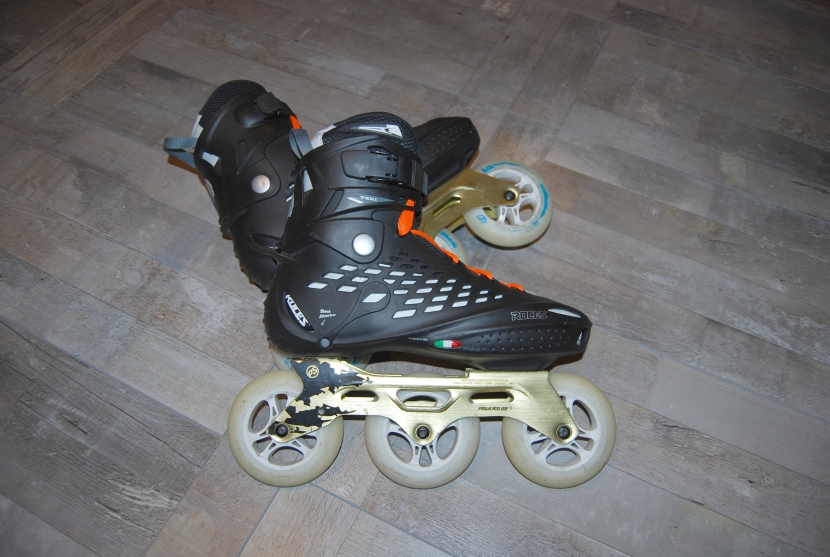
Veni boot gave me a good fit and enough support and was huge improvement over Xsjadoop one. But after a while a problem emerged – the plastic started to „give in” to the metal frame, and whole connection started to be unreliable and flexy. I don’t know if it was my fault of overtightening the screws, or if it happened because of forces that are applied on the boot during skating – but it doesn’t really matter. This setup was compromised and I couldn’t skate it like that – it was risky and took away the fun. I recommend to avoid Veni boot if you want to put together a tall-frame custom. I don’t know if X35 skate shares similar problems, but if Roces is using the same plastic on both shells (and most likely it is the case) I would be cautious with them, too.
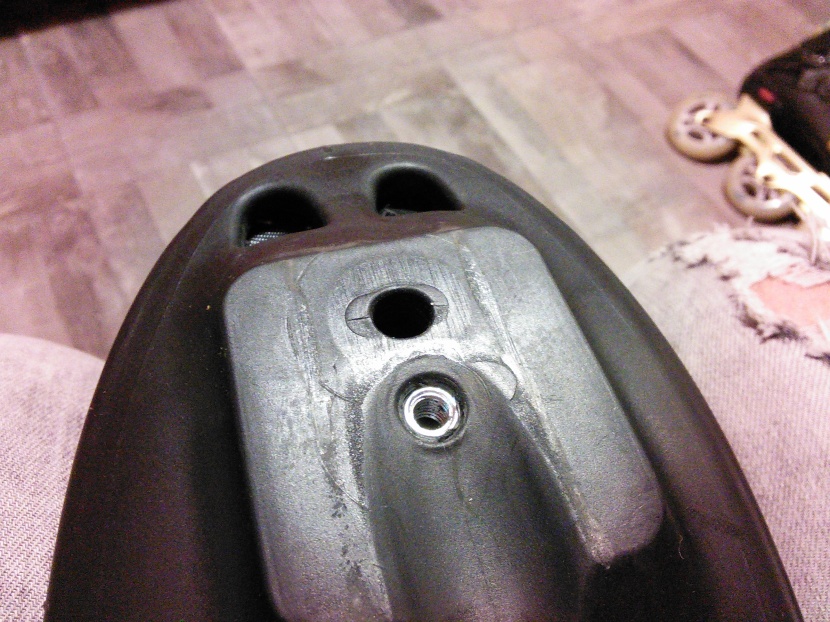
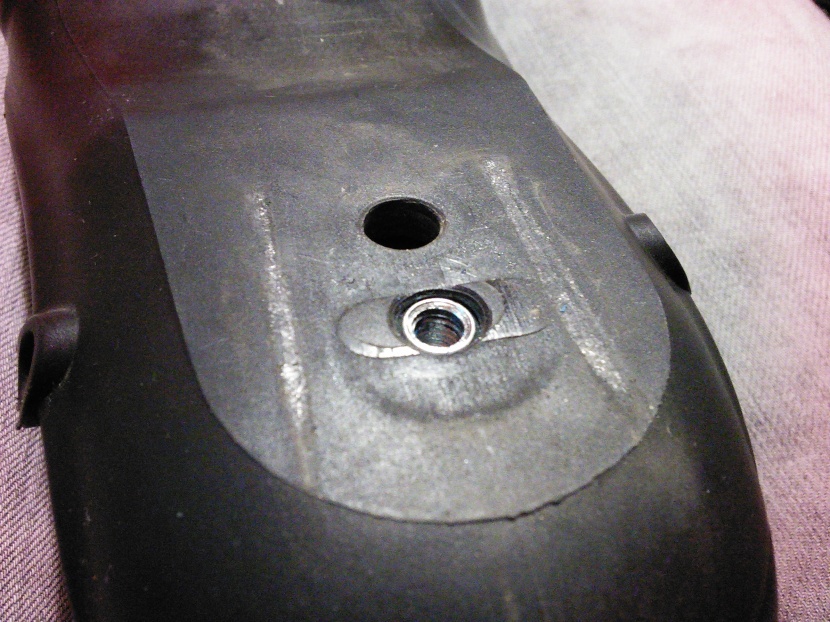
I hit a bargain on used Imperial shells in decent condition and put a new setup together. Imperial boot is by far the hardest skate I own right now, without a doubt, so there’s plenty of support. Frame and boot connection is solid thanks to metal plates of X-Slot. Powerslide is selling complete Imperial Megacruiser sets, and it’s easy to see why – boot and frame work together very good. I use superb USD Phoenix liner and I’m quite happy with this setup, even if they could be a bit wider in ankle area.
Wiser from experience with three different boots, I can say your best bet is to get a hard plastic boot with metal plates for a frame mount (or carbon slalom skate, they are also stiff enough). I think, because of increased height, forces that work on frame and boot connection are stronger than in case of 4x80mm frame, for example. Metal plates in boot give you confidence that this area won’t fail and provide better energy transfer, and thus more fun from skating. Some skates might require slight modifications to use Megacruiser set, but I think all most popular models should take 3x110mm frames without any. Generally speaking, if you have a boot with v-type 165mm frame mounting, chances are you are good to go.
My experience of skating these frames? It is great fun, and even during the time when I’ve used my first, most flexible setup, I’ve enjoyed it. Period of adaptation to such tall skates was surprisingly short and I’ve felt confident on them in no time. I’ve even played a game of Frisbee with those on and forgot what I’ve got under my feet. I think frame length of 255mm helped here, because I’m used to it – my trusted setup of 4x84mm wheels is the same. Comparing the two, there are many differences, though.
Obviously, these frames aren’t made of magic, and won’t make you ten times faster on your blades. Skates are a bit harder to control, not only because of distance from the ground, but also because of one contact point less and losing some grip with it. It’s really noticeable when rear and front wheel wear down from skating a bit – on sharp turns they can lose their grip, especially if you are skating on really smooth surface. Of course, wheels play a huge role here – I’m using PS Infinity wheels, which are budget ones. But there are many models of 110mm wheels with superior grip to choose from.
While skating on flat ground, 3x110mm setup isn’t much faster than 4x84mm one – maximum velocity is similar, but to be honest how fast you are going depends more on you than on your skates (if you have decent ones, that is). But bigger wheels for sure help in maintaining the speed for longer periods of time and make skating at high speeds less tiring. Downside is, acceleration is worse and 3x110mm is less forgiving on uphill. But to sum it up, I’m skating through city faster, because higher speeds consume less energy and larger wheels give me a better roll on surfaces where 4x80mm and 4x84mm clearly struggle.
Jumps are possible but it’s clear these frames weren’t made for them. Especially if you want to do really long and high jumps, you’d be better off with more traditional setup, because height plays a huge role here. Chances are you are not Dustin Weberski or some Canadian mushroom wizard that can jump on those without a sweat.
I’ve always thought (not literally always, but after experimenting with various setups) that frame length of around 255-260mm gives best compromise between stability and agility in urban skating, and it applies to Supercuiser frame too. They feel stable during pushes but don’t give „on rails” sensation that is common with 4x90mm to 4×110 setups.
Here in Cracow we have a long slope that is rather steep and you can go really fast on it. You don’t even have to push, and you are at the bottom in no time. Skating downhill on those frames was faster than on other setups I regularly use, also when I was on flat ground already, wheels rolled for longer. But I got a „shimmy” effect in one skate and had to tense the muscles in that leg to counter it. It was uncomfortable sensation and I wouldn’t take this setup on extreme downhill, mind you.
Supercuiser/Megasruiser frames are quite simple and low-tech, but they are quite ok. There is one minor flaw here, with male part of axles – it’s really easy to damage them, they are quite fragile. Other owners of these frames I know, have the same problem. I hope PS fixes it eventually.
Because frames are pressed, not extruded and CNC machined, they are made with less precision. First and rear wheel can be put easily and I even have to press frame walls together to tighten the axle properly, but middle wheel is really hard to put in. It’s nothing compared to Level 2 frames where I’ve used actual hammer to put middle wheels in, but still, a bit annoying.
If option to go with 125mm wheels doesn’t interest you, and you want shorter frames, right now you can choose from these 3x110mm ones:
-Powerslide Pleasure Tools, 243mm length (like 4x80mm freeskate frame!)
-Seba 310, 247mm length
-Flying Eagle Supersonic, 251mm length
It’s almost like three companies agreed that each one of them will make a frame that is 4mm longer than what came out before, haha!
They are all made in extruded aluminium, so they should be more durable in the longer run than pressed frame, but alloy quality plays huge role here, too. More frames are about to come, and lately Powerslide made more expensive Triple X Megacruiser that is used on shiny Megacruiser Pro skate. Fila is planning to launch their own „speedslalom” skate on 3×110 setup next year.
It’s worth to note, that in most cases, a pair of good 3×110 frames will cost you about the same, or even more, than a full Megacruiser frameset with wheels and bearings included. One can’t deny great value here, and the fact it’s right now the cheapest way to put together a three-wheeled setup.
To sum it up, my experiences with 3x setup are generally positive. Skating on these frames is pleasant and a bit different, and while I’m sure they won’t change anybody’s view on skating, it’s worth trying the thing. Especially if you are looking for skates that are both fast and manoeuvrable, that are fit for urban skating but for long distance cruising as well, it’s worth investing in frameset at least. Many skaters say it’s just another fad, a marketing play to increase sales. I’m not a fool to think whole buzz around three wheeled setups is for nothing and money are not at the stake – Powerslide wants to be ahead of competition and that’s what every company out there should be after, because it’s what brings progress. It doesn’t change the fact idea is worth trying at least. 3x skates already earned their place among my favourite setups and I think I’ll still skate them years from now on.
Go, get them and have fun!
P.S. It’s worth to check out Thias’ blog, author did a short review on Powerslide Pleasure Tools frames:
Thias’ Blog 3x110mm FSK Frames review
Even though he doesn’t post much content nowadays, it’s worth visiting his blog from time to time – it was huge help for me when I got in to skate modding and I’ve learned quite a few useful things from here. It does seem his general impressions of skating 3x110mm setup are close to mine, even though he uses shorter frames.
Three-wheeled skates – what’s the deal about?
This is older, first version of the article. Much more recent that includes more info and insight on three wheeled setups can be found here: CLICK
This one stays only so people who re-posted or shared this post won’t be left with dead links!
Hi there!
(After a very long break)
If you are following current trends in rollerblading world, you most likely noticed that Powerslide is pushing tri-wheeled skates, and basically in all branches (aggressive inline excluded for obvious reasons). They even made new logotype of tri-wheeled skate which is basically a nod to original Rollerblade logo, but of course more dynamic and modern – it’s almost like they are shouting: It’s a new beginning for inline skating! Or something along these lines.
Their „poster child” is new 3x125mm beast of a speedskate called Double-X 3 Wheeler. But they also offer other solutions dedicated to fitness skaters, freeskaters and even slalom skaters (of course not for freestyle slalom, for speed slalom) in form of complete setups, frames or framesets. They come in two flavours – you can get yourself 3x110mm or 3x125mm ride.
To be honest, tri-wheelers aren’t anything truly new. Yup, 3x125mm setups are first of their kind, but frames for 3x100mm and 3x110mm wheels existed for a long time. Powerslide themselves made Venom Double X 3x100mm frame years ago, and while it was able to withstand usage by adult bladers, it was for the most part dedicated to children who speedskate (lower weight than 4x100mm setup, shorter frame better suited for smaller feet etc.). They’ve made Phuzion Open Air fitness skate with 3x110mm before they decided to expand the concept to a broader range of skates. Companies like Fox and dMb also made their own 3x110mm for quite some time. There are more examples but it’s pointless to list them all here. What matters is that trend is coming back, and it isn’t Powerslide alone that is on board. This wall of text will focus mostly on their product, because that’s the one I’ve came in to possession lately.
Do yourself a favour and watch this video before reading further:
Some people might wonder – why Powerslide, all of sudden, decided that tri-wheeled setups are a way to go not only in speedskating, but in fitness and freeskating too?
From my perspective it is obvious that rollerblading market was pretty much stagnant for a while, especially in fitness range. Nothing truly new or exciting was released for years, just another versions of softboots with frames that could take 4×80 to 3x100_1x90 wheel sizes. Current, most popular hardshell freeskates are basically all Tecnica Twister clones, tweaked and tuned, but you can clearly see where their roots are. Nobody wants to follow Salomon design school in FSK world and even RB is slowly killing off my favourite skates of all time, Fusions. It’s a no-brainer that companies would look for something to revitalize the sport they are make money from. To wow the masses again.
Recently I got myself a pair of frames that were taken off Vi Fothon. Bought them second-hand with wheels and bearings for a decent price. These are basically first version of frames that are sold with new, super yellow Imperial Megacruiser skates. Only visible difference is early model have front bridge extended to allow for 195mm frame mount. In the new one, hole for 195mm mounting is not present to allow for 125mm wheels – it is possible to mod older to allow for the same.
Frames measure 255mm in length and are quite tall for a 110mm frame – but on the other hand, they are actually lowest possible frames for 3x125mm setup with 165mm boot and 255mm wheelbase.
I won’t hack my frames to put 125mm wheels in, at least not until I’ll have some other boot to use them with, because as you can see, my hybrid Xsjadoops won’t allow for such large wheels anyway.
 Yeah, I’m using those with my „ghetto” doop skeletons. Reason is straightforward – those are only boots in my possession that actually have raised heel! All my other skates are UFS and won’t work with those frames.
Yeah, I’m using those with my „ghetto” doop skeletons. Reason is straightforward – those are only boots in my possession that actually have raised heel! All my other skates are UFS and won’t work with those frames.
To be honest, this boot is probably one of worst case scenarios if you think about using these frames. It’s not that it is bad – Xsjados and doop are holding your feet very firmly if you tighten up buckle and straps properly. It’s about how flexible it is – they offer just enough support to not worry about twisting ankles on a ride of that height, but not much else.
I think Powerslide R&D team also realized that and that’s why newest version of doop Swift model ditches straps completely in favour of buckles – yes, there’s even a micrometric buckle instead of toe strap. That solution certainly adds some rigidity. I don’t know about 2.0 cuff, because I haven’t used it. But I really doubt that experience of skating doop Swift version 3.0 is worlds apart from skating my hacked, bastard child of Xsjado parts and doop baseplate. It is „heavy-duty” fitness skate at best. I really feel that there’s wasted potential, especially at higher speeds and with harder pushes, when boot flexes too much.
But saying that, I’ve had tons of fun skating these in last few days. Adaptation period to setup so tall was surprisingly short and I feel pretty much confident on them now. It helps that frame is 255mm – which happens to be length of my favourite freeskating frame, 4x84mm RB Fusion.
Compared to 4x84mm setup there are many differences, though. Be aware that those frames aren’t made of magic that will make you ten times faster. If you look for something like that, get a racing motorbike or a sports-car instead.
For starters, skates are a bit harder to control – not only because of increased height, but also because less grip three wheels give when cornering. Of course, stock Powerslide Infinity wheels aren’t Matter Juice, but it’s more about a sensation that three wheels do not „hold” the surface you skate on as good as four.
3x110mm isn’t really that much faster than 4x84mm setup – truth is, speed you can achieve mostly depends on you. Larger wheels help to maintain high speed for longer, with less effort, but your maximum velocity is arguably more or less the same on both setups. 3×110 helps a lot when you get to your maximum (or desired) speed. This setup have slower acceleration, but also slower deceleration rate. So skating at higher speeds is less tiring and you can do it on longer distances.
You can even jump on those, but lest’s be perfectly clear – this is not what you should be looking for if you want to do large gaps. Setup height plays huge role here and those are extraordinary tall. You are probably not Dustin Weberski or some Mushroom Wizard who can handle setup so high without a sweat, so more traditional 4x80mm or 4x84mm frames would be better if you jump a lot. Below are pictures to give you idea how much difference is between 3×110 setup and 4x84mm setup (yellow Fusions), 4x80mm (red Fusions) and 72mm (Xsjados with Level 2).
Considering length, 255mm frame is perfect trade-off between stability and turn-ability, in my opinion, and it works well here too. It’s just enough to have stable wheelbase while pushing, but you do not feel like „on rails”, sensation that is common with 4×90, 4×100 and 4×110 setups.
But, if you still want more agile blades and large wheels at the same time (and 125mm option doesn’t interest you) Powerslide got you covered. They are selling 243mm 3x110mm frame called Pleasure Tool. It is of better build quality – machined 7005 grade aluminium while Super/Megacruiser frames are made from 6063 grade aluminium sheets that have been cut and pressed in to a shape. But Pleasure Tool frame alone cost more than full Megacruiser frameset, with wheels and bearings included!
To get most out of 3×110 or 3×125 frames you’ll want at least a hardboot freeskate. Powerslide is making Vi Supercruiser for those who look for a high-end fitness boot (110mm setup), but Imperial Megacruiser is better option for those who want to abuse their skates a little more.
Outside of Powerslide realm I’ve already seen megacruiser framesets coupled with boots of RB Twister, Seba FR and even more exotic Flying Eagle Falcon skates. There are of course many other hardshell freeskate boots that will do the job just fine – Roces X35 (or Veni, Vidi, Vici), Fila NRK, RB 80 to name a few. If it does have standard 165mm raised heel mount then you are set to go. Some may require light modification to the underside of the boot at the front mounting point, to fit 125mm wheels, but that’s nothing that should stop you in your pursuit of a three-wheeled experience.
Still, 3×110 and 3x125mm belong more to a realm of speedskating than freeskating. That where they came from. Low-cut carbon boot is out of equation if you are looking for reliable urban skating setup. Best thing to do is using those frames with slalom type boot. High cuff will get you support needed in urban environment, while rigid, tight and responsive construction will allow you to skate with maximum efficiency.
There are many such skates nowadays, most common ones are made by Powerslide and Seba. There are also other brands. And there’s Adapt Hyperskate Zero. Which costs 375 Euro for a boot alone.
Personally I would love to put together setup with those boots, but dropping that amount of money is not an option while I’m saving for other, more important things, than a fifth pair of skates. I think I’ll hunt for second hand HC Evo or wait for after season sales, as especially Powerslide S4 skates tend to drop price heavily during those. They’ll do the job. Maybe not in a handmade, carbon-kevlar weave, natural skin, heat-mouldable fashion, but still, they’ll do the job.
To sum it all up – yeah, I’m happy with my Supercruiser frameset. I’m sure that Megacruiser frameset would be 15mm of fun more. If you want to try something that skates differently, or simply want fast, agile setup for skating longer distances, it’s worth investing in those. Some people say it’s just a gimmick, but it is a gimmick that skates good. Worth trying at least, to see what all the fuss is about.
Be sure to visit official Powerslide site to learn more about their three wheeled skates.

